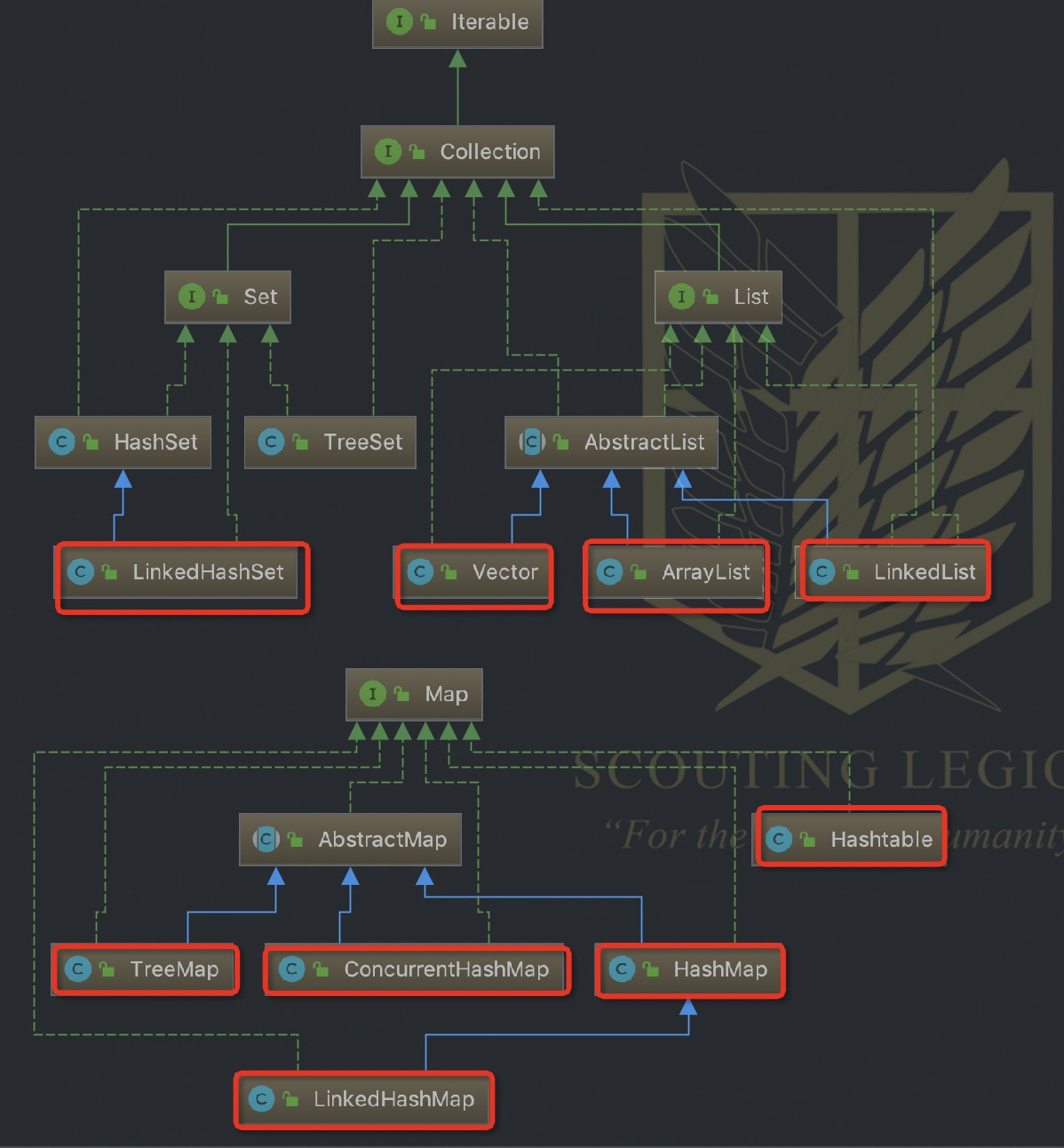摘要
-
Java集合框架总览
Collection
List
ArrayList、Vector、LinkedList
Set
LinkedHashSet、TreeSet
Map
HashTable、HashMap、TreeMap、LinkedHashMap、ConcurrentHashMap
-
Iterator源码分析
-
实现Iterable接口可以使用foreach,Iterable接口主要提供一个返回Iterator的方法。
-
Iterator提供HasNext、next、remove等遍历容器方法,其实现由子类(ArrayList、AbstractList等)实现。
-
ListIterator接口是Iterator的子接口,在原来迭代器接口的基础上又增加了一些新的方法,允许向前、向后两个方向遍历
-
-
foreach和迭代器
foreach是java的语法糖,其实现是通过Iterator和wile实现的。
-
for循环和foreach
- 这两个都是遍历数据容器的方式,但两者有根本性的差别:for循环是通过循环的方式去遍历数据,而foreach是通过while循环+迭代器的方式遍历数据。
- foreach遍历容器的时候,如果对容器进行了add/remove操作,会抛出ConcurrentModificationException异常。但也不是所有容器,Java提供的fail-safe(java.util.concurrent包下的容器都是fail-safe)机制的容器就可以在遍历的时候add/remove。
-
ConcurrentModificationException异常出现的原因
-
为什么foreach遍历ArrayList的时候,remove元素会抛出异常?
ArrayList中有类变量modCount记录了ArrayList变化的次数,每次在add/remove的时候会自增,当调用ArrayList.iterator()方法的时候会new一个内部类Itr,并在初始化Itr的时候赋值expectedModCount=modCount。
当ArrayList再调用add/remove方法的时候modCount会再次自增,但expectedModCount并不会随之改变。最终在遍历时调用Itr.next()校验modCount是否等于expectedModCount时抛出异常。
-
为什么用迭代器遍历时,remove元素就不会抛出异常?
迭代器遍历时,调用Itr.remove()时会再次令expectedModCount=modCount,所以在Itr.next()判断时会通过校验。
-
前言
集合是Java语言里的重要部分,面试时必定会问的问题,都知道集合会问 ArrayList、LinkedList、HashMap等,但有时看的博客太过片段,没有对整个集合框架有较完整的认知,本文是Java集合部分的前序,包含以下几个部分:
- 介绍Java集合框架中重要的接口和类。
- 对迭代器接口Iterator进行源码分析。
- 对接口Collection和Map进行源码分析。
Java集合框架总览
集合框架主要3个:List、Set、Map,看一下类图(图中红框框出的是在面试中最多问到的和平时使用最多的类)

- Collection和Map都是在
java.util包下的,而ConcurrentHashMap是在并发包java.util.concurrent下。- Map和List、Set不同,不是Collection的实现类,并且也没有实现Iterable,这也是为什么不能直接通过foreach的方式去遍历Map的原因
接口Iterator源码分析
我们知道集合是用来存放数据的容器,我们经常也需要去遍历整个容器,去获取数据,操作数据,这就有了迭代器的意义。
Collection接口是Iterable的子接口,Iterable这个接口的作用在其类声明中也可以看到,也就是实现了这个接口的类可以使用for-each的循环。

那么为什么实现了这个接口就可以遍历了呢?
其实这个接口最主要的方法是返回一个Iterator接口,在Iterator接口中,主要方法是我们熟悉的hasNext() next() remove()。
Iterable 可遍历,Iterator遍历器
1.8之后Iterator接口中新增了一个forEachRemaining方法,方法作用是将每个元素作为参数发给action来执行特定操作
既然这个迭代器是接口,那么其具体实现是怎么实现的呢?我们以ArrayList为例,在ArrayList中重写了Iterator()方法(如下),可以看到new了一个Itr对象,这个Itr是ArrayList的内部类,并实现了Iterator接口。
public Iterator<E> iterator() {
return new Itr();
}
/**
* An optimized version of AbstractList.Itr
*/
private class Itr implements Iterator<E> {
int cursor; // index of next element to return
int lastRet = -1; // index of last element returned; -1 if no such
int expectedModCount = modCount;
Itr() {}
public boolean hasNext() {
return cursor != size;
}
public E next() {
...
}
public void remove() {
...
}
public void forEachRemaining(Consumer<? super E> consumer) {
...
}
}
有了上面的源码分析,当试着去看LinkedList的迭代器实现,会发现其iterator()方法调用的是父抽象类AbstractList的iterator()方法。原来在抽象类AbstractList中也重写了iterator()方法,并定义了一个Itr()的内部类,跟ArrayList很相似(还不知道为什么要在ArrayList中又重写一次)。这里整理了一下Java集合框架迭代器的实现。
| 类 | 迭代器实现 | 说明 |
|---|---|---|
| ArrayList | ArrayList定义的内部类 | |
| LinkedList | AbstractList中定义的内部类 | |
| Vector | Vector定义的内部类 | 方法级synchronized |
| Set | map.keySet().iterator() | TreeSet、LinkedHashSet同样 |
| Map | Key、value、entry继承AbstractSet,有实现iteratable接口 |
对于List其实现较为相似,都是会在内部定义一个Itr的类,然后iterator()方法是返回一个Itr内部类的实例对象,但Set的iterator()方法实现令人惊讶,并且Map没有继承Iterable接口,却也有iterator()方法(是在Map的内部类keySet等中有),这部分的源码会在后面对List、Set、Map的深入分析中展开。
ListItr
在List中,无论是AbstractList还是ArrayList、Vector都有一个ListItr的内部类。
private class ListItr extends Itr implements ListIterator<E> {
ListItr(int index) {
cursor = index;
}
...
}
ListIterator接口是Iterator的子接口,在原来迭代器接口的基础上又增加了一些新的方法,允许向前、向后两个方向遍历 List
foreach和迭代器
foreach其实是Java提供的语法糖,我们看下用foreach的循环反编译之后的是如何的。
原代码:
List<String> userNames = new ArrayList<String>() {{
add("Hollis");
add("H");
}};
for (String userName : userNames) {
if (userName.equals("Hollis")) {
userNames.remove(userName);
}
}
反编译之后的代码:
public static void main(String[] args) {
List<String> userNames = new ArrayList<String>() {{
add("Hollis");
add("H");
}};
Iterator iterator = userNames.iterator();
do
{
if(!iterator.hasNext())
break;
String userName = (String)iterator.next();
if(userName.equals("Hollis"))
userNames.remove(userName);
} while(true);
System.out.println(userNames);
}
原来foreach的实现是通过Iterator和wile实现的。
for循环和foreach
这两个都是可以实现遍历数据容器的方式,但两者有根本性的差别:for循环是通过循环的方式去遍历数据,而foreach是通过while循环+迭代器的方式遍历数据。
如果在遍历集合的时候,对集合进行了add/remove操作,那么for循环和foreach循环会有什么不同呢?我们看下下面这个例子:
public class Main {
public static void main(String[] args) {
ArrayList<Integer> list = new ArrayList<>();
list.add(1);
list.add(2);
list.add(3);
list.add(4);
new Main().run2(list);
System.out.println(list);
}
private void run1(List list) {
for (int i = 0; i < list.size(); i++) {
list.remove(i);
}
}
private void run2(List<Integer> list) {
for (Integer i : list) {
list.remove(i);
}
}
}
结果一目了然:
run1运行结果:[2, 4]
run2运行结果:Exception in thread "main" java.util.ConcurrentModificationException(记住这个异常,后文会进行分析)
上面的结果应该都没什么疑问,foreach中不要对遍历对象进行add/remove这几乎是常识了(但也不是所有的容器,fail-safe的容器就可以遍历的时候add/remove),但如果我们将输入的list的长度改为2时,输出结果是否会报异常呢?
public static void main(String[] args) {
ArrayList<Integer> list = new ArrayList<>();
list.add(1);
list.add(2);
// list.add(3);
// list.add(4);
new Main().run2(list);
System.out.println(list);
}
private void run2(List<Integer> list) {
for (Integer i : list) {
list.remove(i);
}
}
输出结果:[2] , 输出结果并没有抛出ConcurrentModificationException异常
这是为什么呢? 我们从源码的角度去分析一下这个问题。
ConcurrentModificationException异常出现的原因
我们用反编译之后的代码看一下:
public static void main(String[] args) {
List<Integer> list = new ArrayList<String>() {{
add(1);
add(2);
}};
Iterator iterator = list.iterator();
do
{
if(!iterator.hasNext()) // 2
break;
Integer i = (Integer)iterator.next(); // 3
list.remove(i); // 1
} while(true);
System.out.println(list);
}
在ArrayList中搜索一下ConcurrentModificationException异常,发现与上述代码相关的就是迭代器的next()方法。对于ArrayList,其迭代器是内部实现的Itr内部类,在next方法中会首先调用checkForComodification方法,代码如下:
public E next() {
checkForComodification();
...
}
final void checkForComodification() {
if (modCount != expectedModCount)
throw new ConcurrentModificationException();
}
哦!原来modCount != expectedModCount就会抛出ConcurrentModificationException异常。
分析到这里,我们可以先回答一下上节的问题:
为什么当list的长度为2是,使用foreach遍历集合,并对集合进行remove操作,并不会抛出ConcurrentModificationException异常?
答案就是,抛出异常是在迭代器的next()方法中,会先校验modCount 是否 expectedModCount。而集合长度为2时,在第一次remove之后再调用迭代器hasNext()就直接跳出循环了。
现在我们接着将modCount和expectedModCount是什么。modCount代表对ArrayList的操作次数,每次add/remove都会使modCount++,而expectedModCount是ArrayList内部迭代器的修改次数,当调用ArrayList的iterator方法时,会new Itr,并在此时对expectedModCount赋值为modCount。
//调用ArrayList的iterator()方法会new Itr
public Iterator<E> iterator() {
return new Itr();
}
//Itr初始化的时候,expectedModCount会赋值为modCount
private class Itr implements Iterator<E> {
int cursor; // index of next element to return
int lastRet = -1; // index of last element returned; -1 if no such
int expectedModCount = modCount;
所以,expectedModCount只在Itr初始化(也就是调用ArrayList的Iterator方法)的时候会赋值为modCount ,如果后面又对ArrayList修改了(add/remove),那么modCount++,但expectedModCount并不会改变,所以就造成了modCount != expectedModCount
我们在看下面的代码:
public static void main(String[] args) {
ArrayList<Integer> list = new ArrayList<>();
list.add(1);
list.add(2);
list.add(3);
list.add(4);
Iterator<Integer> iterator = list.iterator();
do{
if(!iterator.hasNext()) {
break;
}
Integer i = iterator.next();
iterator.remove(); //和上面的代码只是改变了这行! list换成了iterator
}while (true);
System.out.println(list);
}
这是用迭代器去遍历的通常实现,结果一目了然,输出结果:[]
但为什么第12行代码,list.remove()换成iterator.remove()就不会有异常了呢?
public void remove() {
if (lastRet < 0)
throw new IllegalStateException();
checkForComodification();
try {
ArrayList.this.remove(lastRet);
cursor = lastRet;
lastRet = -1;
expectedModCount = modCount; //LOOK AT ME!
} catch (IndexOutOfBoundsException ex) {
throw new ConcurrentModificationException();
}
}
在代码第10行,会对再次expectedModCount赋值为modCount。所以使用iterator.remove()并不会抛出ConcurrentModificationException异常